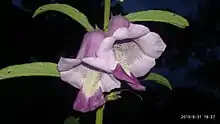Sesamum radiatum
Sesamum radiatum is a species of flowering plant in the Pedaliaceae. It is in the same genus as sesame. It is known by the English common names benniseed, black benniseed,[2] black sesame,[3] and vegetable sesame.[4] It is native to west and central Africa, has been cultivated since ancient times in Africa, and is sometimes also used in tropical Asia where it has become naturalized to a small extent.[2]
| Sesamum radiatum | |
|---|---|
 | |
| Benniseed flowers | |
| Scientific classification | |
| Kingdom: | Plantae |
| Clade: | Tracheophytes |
| Clade: | Angiosperms |
| Clade: | Eudicots |
| Clade: | Asterids |
| Order: | Lamiales |
| Family: | Pedaliaceae |
| Genus: | Sesamum |
| Species: | S. radiatum |
| Binomial name | |
| Sesamum radiatum | |
| Synonyms[1] | |
| |
It is used in Africa as a leafy vegetable;[2][4] the leaves are eaten fresh and cooked. The leaves are slimy in texture when cooked. The shoots are used in soups and porridge.
The seeds are eaten whole or as a paste.[2] The leaves are also used medicinally as a laxative, an antidote to scorpion venom[3] and to treat sprains and ease childbirth.[3]
This plant is an annual herb growing up to 1.2 to 1.5 meters tall. The leaves are opposite, or toward the top of the plant, alternately arranged. The leaves are lance-shaped to oval and up to 12 centimeters long. They may be smooth-edged or serrated. Flowers occur singly in the leaf axils. They are pink to purple in color, sometimes white, and somewhat bell-shaped. They measure up to 5 centimeters long. The fruit is a capsule up to 3.5 centimeters long which contains seeds roughly 3 millimeters long.[2]
This plant grows wild in savanna and other habitat types. It is also a weed of fields and homesteads. It can grow on poor, rocky soils and it flowers even through drought conditions. When cultivated the plant yields 5 to 6 tons of leaves per hectare.[2]
This plant is vulnerable to the leaf spot disease Cercospora sesami. It is also attacked by hawk moths, the moth Antigastra catalaunalis, and the vegetable bug Nezara viridula.[2]
References
- "The Plant List: A Working List of All Plant Species". Retrieved 14 January 2015.
- Sesamum radiatum. PROTA.
- Konan, A. B., et al. (2011). Myostimulating effect of Sesamum radiatum aqueous leaf extract in isolated guinea-pig taenia caeci contractile activity. Afr J Tradit Complement Altern Med. 8(4): 377–385.
- B.M. Auwalu and F.E. Babatunde. (2007). Analyses of growth, yield and fertilization of vegetable sesame (Sesamum radiatum Schum). Journal of Plant Sciences 2: 108-112.